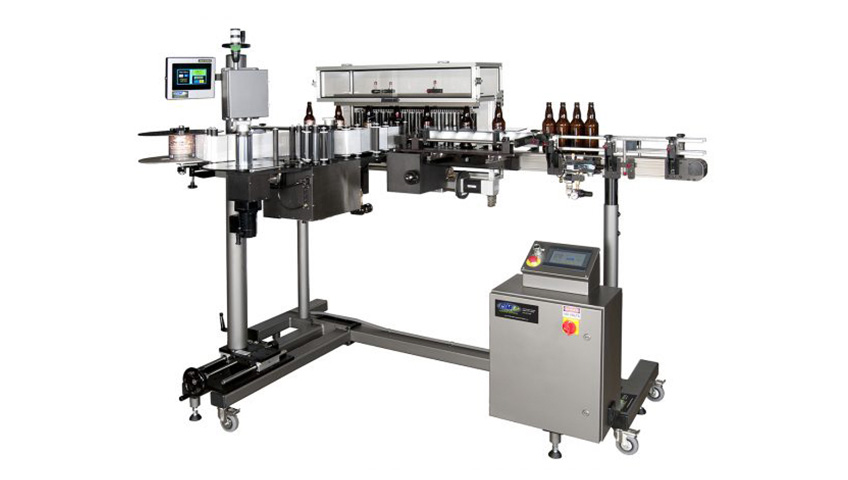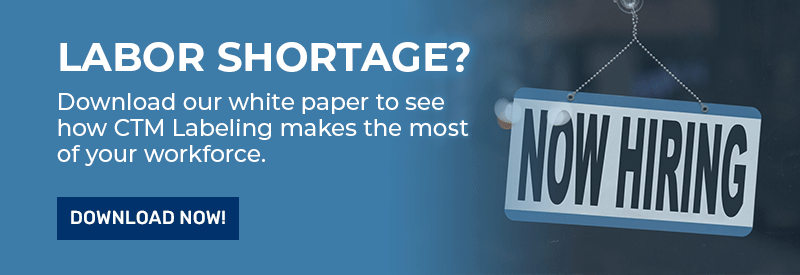
Manual vs. Automatic Labeling: Is Your Business Ready to Make the Transition?
Is business growth forcing you to re-evaluate your production systems? While some processes may be easy to scale, there’s a hard limit on what you can do with manual product labeling. For instance, you may find that it’s relatively easy to double the output of your existing production line, but it may result in a major bottleneck related to packaging.
However, even though buying an automatic labeling machine and setting it up takes considerable capital, once you take into account the savings in labor, production and lost product costs, automatic labeling can significantly cut your labeling costs.
So what factors do you need to consider when contemplating manual labeling vs. automatic labeling?
When Does Manual Labeling Become a Constraint?
The hand labeling process can take several forms–all of which can be relatively time consuming–from peeling and sticking labels by hand to placing containers in a manual labeling machine one at a time and operating a crank or motor.
Human error is always a concern, especially as steps are added to the process.
For example, front and back labels can be applied using one machine, so long as the labels are alternated on the reel. For proper label placement, the operator has to place the container in the machine twice, changing its orientation before the second pass. When you’re labelling thousands of containers each day, it’s inevitable that a few of those bottles won’t be flipped correctly for the second label.
Even the best-trained, most disciplined worker will have lapses and slips that result in faulty labeling. When you make the switch to a high-speed automatic labeler, this error is eliminated. Automatic and semi-automatic label applicators use an orienting device to flip the container or use a pair of applicators to apply both labels at the same time.
Manual labeling equipment, by comparison, has little or no adjustment, which can lead to inconsistencies in application. This is a major problem for wrap labels, as they can twist, bubble and flag during application if the machine’s rollers aren’t perfectly aligned with the container.
If you want to add an expiration date, lot number, or other container-specific information, you need a separate stamping machine or label printer. That means one more step, and one more opportunity for human error. However, a print-and-apply machine can print this information onto labels just before application and then apply the label efficiently and effectively so that the opportunity for error is eliminated.
Hidden Benefits of Switching to Automatic Labeling
Obviously, making the switch from manual product labeling to an automatic labeling system increases labeling speed and accuracy. However, there are other benefits that can improve the cost-effectiveness of your operation.
Manual label applicators are usually built as stand-alone machines, so if something goes wrong, it’s often just easier to buy a new machine. An automatic labeling system, though, is built using the same components as other industrial machines which results in a huge leap in component quality. It also means spare parts and repairs are easy to access. This may not be a major issue if your business is just big enough to consider the switch to automatic labeling, but it can be a huge benefit down the line as you further expand your business.
If you need to make a change to your label sizes or containers, your manual machine probably has major restrictions, so you’ll likely have to get a whole new machine that works with your new packaging.
Automatic labelers use computer control, making it possible to save several presets for a variety of labels and containers. With the right setup, you may be able to replace several manual labelers with a single automatic labeler. If you need to make major changes to your containers or label designs, you can usually add or swap out parts on your automatic labeler to fit these alterations.
Switching to an automated or semi-automatic labeling system lets you use larger label reels. Since these reel sizes are standard across the industry, it can mean significant per piece cost savings by letting you buy your label rolls in bulk.
Which Method is More Cost Effective?
An automatic labeling machine does have a substantial upfront cost, but it can cut running costs significantly. A general rule of thumb is that an automatic machine is worth getting if it replaces the labor of one worker.
However, you may find that the cost benefits of increased accuracy and flexibility outweigh manual labeling long before you dedicate a full time employee to this job. Here’s what you can expect when you switch to an automated system:
– Greatly reduced labor requirements
– Fewer label errors
– Fewer wasted labels
– Ability to adapt labeling for new product lines and sizes
– Built-in service and support, reducing downtime
– Wider variety of label options, reducing labeling costs
Semi-Automatic Labeling: The Mid-Point for Automation and Accuracy
If you’re not ready for a fully automatic label application, you can get most of the benefits with a semi-automatic labeling machine. While an automatic labeler loads itself, a semi-automatic label applicator needs to be hand-loaded. This is handy for products that need a final quality control check before labeling. Eliminating conveyor belts makes these machines smaller and less expensive, and allows them to be set up almost anywhere.
For example, our tabletop wrap labeler handles label orientation and application, eliminating human error and adjustment issues. Containers are carried from the hopper to the applicator with a star wheel. By changing out this wheel, the machine can handle different bottle sizes or containers. If you’re working with low volumes, this is a great way to get the accuracy of automatic labeling without the cost and floor space requirements of a fully automated system.
Labeling Machines You Should Consider When Making the Switch
Our 360a Series label applicator can use merge, blow or tamp-blow application methods, which results in this labeler’s ability to place labels on a wide range of container shapes. It’s also built to be “plug and play,” allowing you to add accessories later on to fit specific labeling requirements (that includes frames and equipment for specialty packaging). The on-board computer can be configured for several label types, and once the machine is calibrated, it’s easy to switch packaging. The electronics are also built into this machine as a single unit that is easy to replace, reducing downtime.
Want a print-and-apply labeling system? Our 3600pa Series labeler is basically a 360a with printing capabilities. It’s compatible with print engines like Sato, Zebra and Datamax, letting you choose the printer that best fits your label requirements. Like the 360a, this machine is built to be upgraded and reconfigured, as needed. The computer stores label calibrations and printing information, making it easy to switch between containers and products. And, by communicating with your OT system, it can gather serial numbers, lot numbers, shipping destinations and other information to add to your labels.
We Can Help You Make a Smooth Transition to Automatic Labeling
Are you ready to improve your business’s labeling system? Contact CTM Labeling Systems to be put in touch with one of our expert local distributors. If you’ve been weighing the benefits of automatic vs. manual product labeling, they can help you put together a labeling system that fits your production needs and budget.





